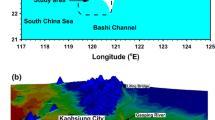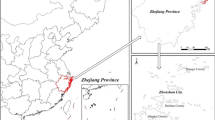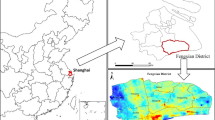Abstract
In the Lower Rhine Delta of the Netherlands, the high water level is driven by a joint impact of the downstream storm surge and the upstream fluvial discharge, and affected by the operation of existing man-made structures. In scenario-based risk assessment, a large number of stochastic scenarios of storm surges are required for estimating the high water level frequency. In this article, a fast computing stochastic storm surge model is applied to the gauge station of Hook of Holland in the west of the Netherlands. A fixed number of tides are considered in this model based on the information of historical storm surge events. Based on this model, a large number of stochastic storm surge scenarios are derived and forced into a one-dimensional hydrodynamic model of the Netherlands, resulting in peak water levels in Rotterdam, the most vulnerable city in the delta. These peak water levels are statistically analyzed and converted to the high water level frequency curve in Rotterdam. The high water level frequency curve in Rotterdam tends to a much lower design water level compared to the official design water level that is used to design the dikes and structures for protection of the city. Moreover, there is a significant difference in the high water level frequency curves due to the fact that the stochastic storm surge model considers different numbers of tides. This highlights the critical impact of the storm surge duration on the high water level frequency in the Lower Rhine Delta.













Similar content being viewed by others
References
Alexandersson H, Schmith T, Iden K, Tuomenvirta H (1998) Long-term variations of the storm climate over NW Europe. Glob Atmos Ocean Syst 6:97–120
Alexandersson H, Tuomenvirta H, Schmith T, Iden K (2000) Trends of storms in NW Europe derived from an updated pressure data set. Clim Res 14(1):71–73. doi:10.3354/cr014071
Barring L, von Storch H (2004) Scandinavian storminess since about 1800. Geophys Res Lett 31(20):L20202. doi:10.1029/2004gl020441
Bijlsma AC (1989) Investigation of surge-tide interaction in the storm surge model CSM-16, WL Rapporten, Report No.Z311, Delft Hydraulics, Delft
Dantzig D, Hemelrijk J, Kriens J, Lauwerier H (1960) Rapport deltacommissie. Staatsdrukkerij En Uitgeverijbedrijf ‘s-Gravenhage 3:218
Gerritsen H, de Vries H, Philippart M (1995) The Dutch continental shelf model. In: Lynch DR, Davies AM (eds) Quantitative skill assessment for coastal ocean models, coastal estuarine stud, vol 47. AGU, Washington, D. C., pp 425–467
Glynn PW, Iglehart DL (1989) Importance sampling for stochastic simulations. Manag Sci 35:1367–1392. doi:10.1287/mnsc.35.11.1367
Gönnert G, Buß T, Thumm S (2010) Coastal protection in hamburg due to climate change. An example to design an extreme storm surge event. In: Proceedings of the First International Conference coastal zone management of river deltas and low land coastlines, Alexandria, Egypt
Jonkman SN, Kelman I (2005) Deaths during the 1953 north sea storm surge. In: Proceedings of the solutions to coastal disasters conference. American Society for Civil Engineers, Charleston, 8–11 May, pp 749–758
Jorigny M, Diermanse F, Hassan R, van Gelder P (2002) Correlation analysis of water levels along dike-ring areas. Dev Water Sci 47:1677–1684
Ministerie van Verkeer, Waterstaat (2007) Hydraulische randvoorwaarden primaire waterkeringen voor de derde toetsronde 2006–2011 (hr 2006), Den Haag. (in Dutch)
Parmet B, van de Langemheen W, Chbab E H, Kwadijk J C J, Diermanse F L M, Klopstra D (2002a) Analyse van de maatgevende afvoer van de rijn te lobith, RIZA Report
Parmet B, van de Langemheen W, Chbab EH, Kwadijk JCJ, Diermanse FLM, Klopstra D (2002b) Analyse van de maatgevende afvoer van de maas te borgharen, RIZA Report
Roscoe KL, Diermanse F (2011) Effect of surge uncertainty on probabilistically computed dune erosion. Coast Eng 58(11):1023–1033. doi:10.1016/j.coastaleng.2011.05.014
Tortosa Alejandra (2012) Calibración de un modelo simplificado del sistema de canalizaciones hidráulicas de Holanda, Master thesis. Escuela Técnica Superior de Ingenieros de Sevilla. (In Spanish)
van Gelder P (1996) A new statistical model for extreme water levels along the Dutch coast, Stochastic hydraulics ‘96, edited by: Tickle K S, Goulter I C, Xu C C, Wasimi S A, and Bouchart F, pp 243–249
van Overloop PJ (2009) Operational water management of the main waters in the Netherlands, Technical Report, Delft University of Technology, Delft, the Netherlands
van Overloop PJ (2011) Prediction and Control of the entire Delta and River System of the Netherlands, Report for Water INNovation (WINN), Delft, Delft University of Technology
Verlaan M, Zijderveld A, de Vries H, Kroos J (2005) Operational storm surge forecasting in the Netherlands: developments in the last decade. Philos Trans R Soc Math Phys Eng Sci 363:1441–1453
Wahl T, Jensen J, Mudersbach C (2010) A multivariate statistical model for advanced storm surge analyses in the North Sea, Coastal Engineering Proceedings, 1(32), currents-19. doi: 10.9753/icce.v32.currents.19
Wahl T, Mudersbach C, Jensen J (2011) Assessing the hydrodynamic boundary conditions for risk analyses in coastal areas: a stochastic storm surge model. Nat Hazards Earth Syst Sci 11:2925–2939. doi:10.5194/nhess-11-2925-2011
WASA-Group (1998) Changing waves and storms in the northeast atlantic? Bull Am Meteorol Soc 79:741–760. doi:10.1175/1520-0477(1998)079<0741:CWASIT>2.0.CO;2
Zhong H, van Overloop PJ, van Gelder P, Rijcken T (2012) Influence of a storm surge barrier’s operation on the high water level frequency in the Rhine delta area. Water 4:474–493. doi:10.3390/w4020474
Zhong H, van Overloop PJ, van Gelder P (2013) A joint probability approach using a 1-D hydrodynamic model for estimating high water level frequencies in the Lower Rhine Delta. Nat Hazards Earth Syst Sci 13:1841–1852. doi:10.5194/nhess-13-1841-2013
Acknowledgments
This work was partly supported by the 111 Project (No. B08048). We appreciate the professional comments from Thomas Wahl and an anonymous reviewer on the draft paper.
Author information
Authors and Affiliations
Corresponding author
Appendix
Appendix
-
1.
The peak height of the storm surge P10 fits the generalized Pareto distribution:
$$f(h_{{{\text{P}}_{10} }} ) = \frac{1}{\sigma }\left( {1 + \xi \frac{{h_{{{\text{P}}_{10} }} - \mu }}{\sigma }} \right)^{{ - \left( {\frac{1}{\xi } + 1} \right)}}$$where the shape parameter ξ is 0.0143; the scale parameter σ is 0.2390 m; the location parameter u is 2.15 m.
-
2.
The marginal distribution of high Rhine discharge Q r fits the generalized Pareto distribution:
$$f(Q_{\text{r}} ) = \frac{1}{\sigma }\left( {1 + \xi \frac{{Q_{\text{r}} - \mu }}{\sigma }} \right)^{{\left( { - \frac{1}{\xi }} \right) - 1}}$$where ξ is the shape parameter; σ is the scale parameter; u is the location parameter; and the parameters’ values are −0.0667, 1,629.7 and 6,000 m3/s, respectively.
-
3.
The marginal distribution of the associated Meuse discharge Q m fits the Log-normal distribution:
$$f(Q_{{\text{m}}} ) = \frac{1}{{\sigma \cdot Q_{{\text{m}}} \cdot \sqrt {2\pi } }}e^{{ - \frac{{(\ln Q_{{\text{m}}} - \mu )}}{{2\cdot\sigma ^{2} }}}}$$where μ is the mean value 6.8667; σ is the stand deviation value, 0.3752.
-
4.
The joint cumulative probability distribution of high Rhine discharge and high Meuse discharge fits a Gumbel Copula function:
$$F_{{Q_{{{\text{r}},}} Q_{\text{m}} }} (Q_{\text{r,}} Q_{\text{m}} ) = C_{\alpha } (u,v) = \exp \{ - [( - \ln u)^{\alpha } ] + ( - \ln v)^{\alpha } ]^{{\frac{1}{\alpha }}} \}$$$$u = F_{\text{r}} (Q_{\text{r}} ) \,$$$$v = F_{\text{m}} (Q_{\text{m}} )$$$$\alpha = \frac{1}{1 - \tau }$$where the relationship between the Gumbel copula parameter α and Kendall’s tau τ is also shown. α is estimated as 1.7158; F r is the marginal cumulative distribution of high Rhine discharge; F m is the marginal cumulative distribution of the associated Meuse discharge.
Rights and permissions
About this article
Cite this article
Zhong, H., van Gelder, P.H.A.J.M., van Overloop, P.J.A.T.M. et al. Application of a fast stochastic storm surge model on estimating the high water level frequency in the Lower Rhine Delta. Nat Hazards 73, 743–759 (2014). https://doi.org/10.1007/s11069-014-1104-9
Received:
Accepted:
Published:
Issue Date:
DOI: https://doi.org/10.1007/s11069-014-1104-9




